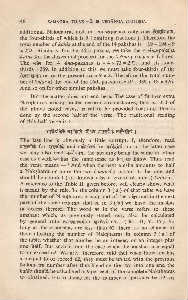Page 694 - Lokmanya Tilak Samagra (khand 2)
P. 694
46 SAMAGRA TILAK- 2 • VEDANGA JYOTI~HA
additional NaktJbatra, and in conseqqence only one ~~.
the four-thirds of which is 9 (omitting fractions ). Th.;:refore the
total number of kalds at the end of the 14 pakshas is = 19 + 194 t9
= 2-22. Similarly for the 16th paksha we take the 4 una~paksha
kahis for the dozen and proceed for the 4 una-pakshas as follows.
The ~ for 4 una-pakshas is = 4 x 73 "' .292; and its four-
thirds = 389. In addition to this we must take four-thirds of the
~~~ or in the present case 9 x 2. Therefore the total num,-
ber of kalris at the end of the 16th paksha is = 19 + 389 + 18 = 426.
And so on for other similar pakshas.
But the matter does not end here. The case of further extra
NaktJhatras arising under certain circumstances, that is, 3rd of
the above noted cases, is yet to be provided for; and this is
done by the second half of the verse. The traditional reading
of this half verse is :-
~~sM ~Nlfct q~s~ ~$ ii%"''4-.j II
The last line is obviously a little corrupt. I, therefore, read
~~ for ~~ and if'f~~ for if'f~~~; or in the latter case
we may also read ~~~. the meaning being the same in either
case as -.: with arcr_ has the same sense as ~ to .know. Thus read
the verse means - ' And when the next amsha amounts to half
a Nak~hatra or more the two ( united) is said to be one, and
should be counted ( lit. known ) by a group of nine ( kahis }. '
A reference to the Table II, given before, will clearly show, what
is meant by the rule. In the column 3 ( a) of that table we have
the number of Nak~hatras arising .out of the ~ and in the next
part of the same column, that is, in 3 ( b ) we have the amshas
in excess thereof. The word tR in the verse refers to these
amshas; which, as previously stated, may also be calculated
by general rule 11:'fif~~ll'f~f.:i': ~~sil etc., ( R. 10; Y. 15 ). So
long as these amshas are less than 62 there is no chance of
their affecting the number of Nak~hatras in column 3 ( a ) of
the table, whether that number be an integer, or an integer plus
one half. But such is not the case when the amshas are equal
to or exceed 62. We are, therefore, told that when these amshas
are equal to or exceed 62, they must be united with the previous
NaktJhatra number after thus blending the two into one and the
kalris should be calculated at 9 per each of the complete Nak~Jhatras
so obtained. For instance let the number of pakshas be 19, or

